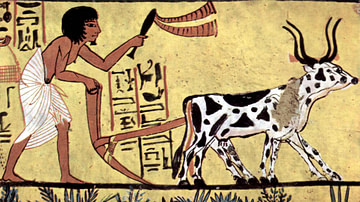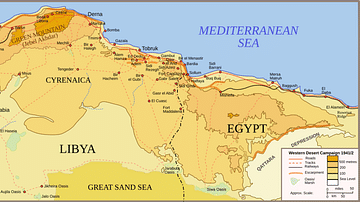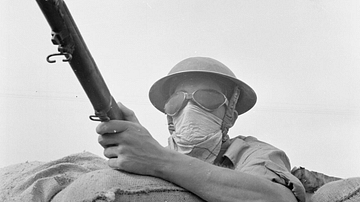The desert campaigns in North Africa during the Second World War (1939-45) provided soldiers on all sides with a set of particular challenges. Scorching day temperatures, freezing night temperatures, sand and flies getting everywhere, the rationing of water, a poor and monotonous diet of tinned food, and the serious risk of being killed or injured by a projectile fired by an enemy one could not even see were just some of the challenges that had to be endured.
The desert theatre of war was also unique for the almost total absence of civilian involvement; who else would choose to be here? The harsh conditions did ensure a certain camaraderie developed as everyone faced the double challenge of surviving the war and whatever the desert could throw at them. In this article, we look closer at daily life in the North Africa campaign through the words of those who experienced it.
Desert Conditions
Temperatures in the desert could reach up to 50 degrees Celsius (122 Fahrenheit) – one could literally fry an egg on any metal part of a vehicle exposed to the sun – but the nights could be freezing, and men died of exposure. Soldiers were warned to stay out of the sun, indeed, in the British Army, not wearing a shirt and getting sunburnt was a punishable offence. With few natural features to hide behind, troops had to become adept at camouflage and concealment, especially to avoid enemy aircraft or mobile patrols. Away from the coastal towns, there were no people except occasional groups of Bedouin nomads.
It was not easy to know where one was or where one was going in the often featureless desert – here more often than not hard-baked flatlands strewn with small rocks and a thin layer of sand rather than the giant sand dunes of the Sahara Desert further south. It was just the sort of terrain to play havoc with a vehicle's tyres. Sand was everywhere, and when the wind blew, there was no escape from it. Vehicles and aircraft had to be fitted with special filters to try and keep the sand from entering and damaging the engines. Sandstorms were, of course, the worst, and these could last from two hours to two days. Sand thrown about in high winds could wear away the skin and literally sand-blast vehicles clean of their paintwork. Men escaped the fury as best they could, as here described by Private Tom Barker:
One bloke who had been cleaning his gun hurriedly put it all back together and others who had been chatting suddenly grabbed trench spades and shovelled at the sand like gophers desperate to get away from a predator. Once they had a hollow dug that would accommodate their body they dug into their pack and got out their cardigans to act as an air filter, then pulling a groundsheet over themselves they hunkered down to wait for the sandstorm.
(Layman, 20)

Troops, or at least somebody within any one group, had to be able to navigate using a compass, the sun, and the stars. Maps did improve as the war went on and numbered barrels were used to help identify the otherwise unidentifiable stretches of desert tracks that criss-crossed North Africa. The sheer scale of the area of battles and lack of recognisable landmarks baffled many of the participants, even confusing such figures as General Erwin Rommel (1891-1944), who once wrote to his wife back in Germany:
I have no idea if the date is correct. We've been attacking for days now in the endless desert and have lost all idea of space or time.
(Allen Butler, 215)
While fighting could be intensive, it was often of short duration. At other times, especially for those troops in defensive positions, overcoming boredom became the greatest challenge. Italian Lieutenant Emilio Pullini remembers:
There were some things we did not like very much, flies mainly and a very hot sun which was above us all day long. It was very uncomfortable to spend all day lying in foxholes from sunrise to sunset just covered in flies and doing very little else because we had no chance of doing anything else.
(Holmes, 271)

The British writer Laurence Durrell (1912-90) recalls the feeling that the fighting was always somewhere else in the vast expanse of the desert:
It's a very funny thing, a battlefield, it's extraordinary how inanimate the whole thing seems. There was a little bit of an action going on in the right-hand corner of some sort, for the rest there were people lying about smoking. It's one of the very singular things that films and books don't bring out…where nothing seems to be happening, the action is always somewhere in another corner and it's a decisive thing. And then they ask you if you were there.
(Holmes, 275)
Clothing
Usual army-issue clothing was adapted for this special environment. For example, officers of the British 7th Armoured Division, the 'Desert Rats', "developed an informal outfit in the desert – silk neckerchief, light cord trousers, suede desert boots, and in the cold weather a goatskin coat from Afghanistan or Persia – with home-knitted balaclavas de rigueur for all ranks in the cold early mornings" (Lyman, 20). Scarfs were a useful addition both for keeping warm and sand out of the face. Steel helmets were used in battle on all sides, often painted sand-coloured with sand and grit mixed in to aid camouflage. Cellophane goggles for tank units became a prized acquisition. Reusing the captured material of the enemy was a common feature of the desert war, and this included clothing, as here described by John Devine, a major in the Australian medical corps:
It was amazing how much scrounging had been going on. We had cases of the most excellent Italian milk, sterilizato, cases of beautiful cherry jam and cases of not so good bully beef. We were using Italian sterilizers for our medical equipment, Italian dressings and many Italian instruments. Everyone seemed to have his own Italian car…Our men were wearing Italian khaki military shirts, and in many cases Italian trousers and boots, and we were all sheltered by Italian groundsheets.
(Lyman, 79)

The initial cotton tropical uniforms with their stiff jodhpur-like trousers and pith helmets used by the Deutsche Afrika Korps (DAK) proved unsuitable for the desert. German troops often kept the laced leather boots and soft long-peaked caps (which shaded the eyes well) they were issued with but loosened their trousers or wore shorts to match their short-sleeved shirts (although in theory, shorts were not permitted in battle). For cool nights they wore, like the British, wool sweaters. Many Afrika Korps troops, until issued with their own versions, even wore Italian-issue Sahara jackets and British overcoats when they could get hold of them. Overall, all sides had a far less strict dress code than normal as men tried to deal with the harsh conditions as best they could.
Hygiene
As water was very often rationed, there was not much spare for washing. All water had to be carried since the local wells were few and far between, not particularly fresh, and certainly not sufficient to supply large groups of troops. Men became adept at shaving and washing using as little water as possible. Dirty water was then used to fill up vehicle radiators. The poor quality of the water available, poor diet, and the heat all combined to make diarrhoea a common problem and dysentery a more successful killer than the enemy. Men were issued with salt tablets to replace the salt lost in perspiration. Vitamin C tablets were also issued, but a cure for desert sores proved elusive.
Flies were everywhere, as desperate for any moisture as the men were. Men ate under mosquito nets to keep the flies from eyes, mouth, and nostrils. A new sport was seeing how many flies one could catch, with league tables showing the most successful fly killers. This entertainment rivalled other means of relaxation like cards, board games, and listening to the radio. Rats plagued defensive positions, too. Scorpions and camel ticks were nasty surprises for many. The most troublesome pest of all, though, were fleas, which proved impossible to eradicate. John Devine remembers:
The fleas were so bad that on waking in the morning one's pyjamas were spotted all over with one's blood…We tried everything - airing all our bedding, spraying it with kerosene, covering everything including ourselves with insecticide, lighting fires on the ground – but nothing seemed to do the slightest bit of good.
(Lyman, 196)

Toilets were non-existent, and so the choice was limitless, as here explained by one British sergeant:
You took a shovel and walked away until you found an empty area. You did whatever you had to do and covered it again. The men knew that they had to cover their excretia because of the flies. You live with the flies all around your mouth and up your nose.
(Mitchelhill-Green, 231-2)
Food
Food preparation in the desert often required some ingenuity, as here explained by Private Harry Buckledee:
We were well equipped with cooking utensils: every vehicle had a frying pan, kettle and dixie [large cooking pot]…Our mainstay was corned beef and biscuits, with potatoes, onions and an Oxo cube for flavouring. We survived mainly on bully stew, with tinned bacon, sausages, soya bean sausages, tinned fruit and always enough tea, sugar and good old Carnation milk to make a brew whenever we wanted one or when we could make one. Sometimes we had boiled rice with sugar or jam and milk. There was flour available on the ration wagon if needed. When we had the time, which wasn't often, we made pastry with the flour and margarine, using a map board for rolling it out on and a beer bottle for a rolling pin. Small pastries were filled with apricot jam and fried in deep margarine. So we didn't starve, although there were many days when we had little time to eat.
(Lyman, 24)
German rations were just as impoverished as those of the Allies, as noted by Lieutenant Joachim Schorm:
We have been away from Germany now for two months and without butter, etc., into the bargain. Our principal food is bread, with something to spread on it. In this heat every bite needs a sip of water or coffee to help it down…Where would you find anybody in Germany who would drink water of this colour and taste? It looks like cocoa and tastes of sulphur.
(Lyman, 218)

Even Rommel bemoaned the poor food available, as he remarks here in a letter to his wife:
Unable to write yesterday, my stomach struck work again. We had a fowl the evening before last which must have come from Ramses II's chicken run. For all the six hours' cooking it had, it was like leather and my stomach just couldn't take it.
(Butler, 290).
The Italians seemed to win the rations stakes. Cyril Joly describes the stores in a captured Italian camp:
…rich red and white wines, cases of matured brandy and liqueurs, bottled fruits, frozen hams and anchovies, tins of beef, sacks of macaroni, potatoes, onions and carrots, minestrone soup…
(Lyman, 55)
Ordinary Italian soldiers were not as well off as their officers. The canned meat they were issued with was called by German troops 'dead man' because of its low quality.
The British became famous for their ability to make tea anywhere. Joly describes how a petrol can became an invaluable addition to one's stores:
We cut in half one of the thin sheet-metal four-gallon petrol tins used at that time, punched it with holes and filled it with sand and gravel. We then poured on a generous splash of petrol and set it alight. The tea we brewed in the other half of the tin. When the water was boiling, tea, sugar and milk were all added and the whole potion was vigorously stirred.
(Lyman, 22)

Alcohol was precious and usually kept for special occasions or victories, as here described by a German panzer lieutenant after a hard day's fighting:
We assembled around the command tank and drank Scotch in the shimmer of innumerable fires…the red light flickered in faces, which were dirty and full of oil. Only our eyes continued to gleam…We had decided a battle; victory was in our hands now.
(Mitchelhill-Green, 291)
Sleeping Arrangements
Men slept, or tried to, wherever they could such as under their armoured vehicle. Those in static defences, such as at the siege of Tobruk, often made the best of things in caves, as here described by Leonard Tutt:
My hole in the ground was about seven feet long, four feet wide and five feet deep. In bed at night it felt rather like a cosy coffin. 'Bed' sounds a bit pretentious but it had become de rigueur for other ranks to have a bed made of a pole framework with a couple of groundsheets laced across them and resting on four petrol cans…All along the walls at the side of my bed I had carved out shaped holes to take my personal possessions: mess tins, mug, book and reading lamp – a tobacco tin filled with paraffin and a piece of frayed cord for a wick.
(Lyman, 194-5)
At the other end of the scale, Italian officers, once again, seemed to have had the best of things. On-the-spot Australian journalist Alan Moorehead describes one captured Italian post at Sidi Omar:
Officers' beds laid out with clean sheets, chests of drawers filled with linen and an abundance of fine clothing of every kind…and dressing tables…strewn with scents and silver-mounted brushes.
(Lyman, 63)

Enemy Fire
Having survived the harsh desert conditions, men faced, of course, a myriad of ways to die under enemy fire, air attacks, and from the countless mines laid by all sides. Cyril Joly describes an epsiode of artillery fire:
From the safety of the firmly closed down turret of my tank, I watched through the periscopes with awe and horror the scene of destruction and suffering which surrounded us. Some of the shells fell wide of their mark, leaving behind them only a cloud of dust and black smoke which drifted slowly across the battlefield, carried by the little breeze there was in the sudden calm. Others fell near the tanks, and we could hear the dull metallic clang as the shell splinters hit the armour plate. Others fell among the small groups of infantry, leaving behind the twisted, mangled and distorted bodies of the dead and wounded.
(Lyman, 44)
Reusing captured equipment was a common feature of this desert war, but this had its hazards. Often explosive booby traps were left in vehicles and camps, even such mundane items as thermos flasks, shaving sticks, and fountain pens could be lethal when packed with explosives.
Those who survived all of these hazards to fight another day were often traumatised by the terrible scenes they had witnessed amongst friend and foe, as here described by Peter Cochrane:
I was never to get used to the terrible lack of dignity in nearly all the bodies; it seemed in a muddled way that if one had to be killed, one had the right to die decently and not to be left lying about in a posture that too often could only be described as ludicrous. The pathetic was easier to bear – the young man, for instance, doubled back over a gun barrel, letters and snapshots of his girl spilling from an unbuttoned pocket. Ludicrous or pathetic, hideously mutilated or clean killed, they were our fellows though in an unfamiliar uniform, and they had to be buried. But I drew the line at extracting the charred remains of men from burnt-out tanks. That was a sight that led to nightmares.
(Lyman, 50)

All of the above trials and tribulations that the desert war presented each day, including the sheer monotony of it all, are memorably summarised here by Robert Crisp, a tank commander:
We went without sleep, without food, without washing or change of clothes, without conversation beyond the clipped talk of wireless procedure and orders. In permanent need of everything civilized, we snatched greedily at everything we could find, getting neither enjoyment nor nourishment.
The daily formula was nearly always the same – up at any time between midnight and 4 o'clock; movement out of the leaguer into battle positions before first light; a biscuit and a spoonful of marmalade before the flap of orders and information; the long day of movement and vigil and encounter, death and the fear of death, until darkness put a limit to vision and purpose on both sides; the drawing in of far-flung formations; the final endurance of the black, close-linked march to the leaguer area; the maintenance and replenishment and order groups that lasted till midnight; the beginning of another 24 hours.
(Strawson, 100)






